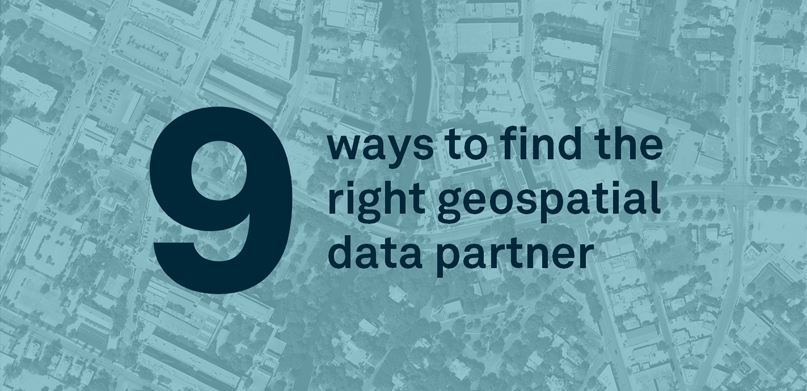When evaluating geospatial data providers, taking the time to analyse each vendor and compare them with your objectives helps
you maximise the odds for success. It’s essential to recognise how seemingly insignificant and inconsequential differences can lead to dramatically different results.
Each provider abides by various standards and quality measures that lead to differences in resolution, positional accuracy, quality, large-area seamlessness, and many other factors. As you’re gathering your requirements and assessing vendors, here are nine traits to look for in finding the right geospatial data partner for you:
![]() 1. Long track record of consistency and currency.
1. Long track record of consistency and currency.
Look for providers that offer consistent, complete coverage of a geographic area. Data should be captured over the same flight lines with the same sensors and image processing methods.
![]() 2. Sticks to a reliable, consistent refresh schedule.
2. Sticks to a reliable, consistent refresh schedule.
While you may require the most recent images in some cases, refresh cycles help track changes over time. This can be especially important in rural areas where coverage availability is limited. Ask the vendor if it has a refresh schedule for publishing updates.
![]() 3. Provides data quality assurances.
3. Provides data quality assurances.
Quality assurances include standards for accuracy and metadata. Carefully compare this information before making any decisions about whose products to use and how to use them.
![]() 4. Uses reliable technology to capture data.
4. Uses reliable technology to capture data.
Different sensors and equipment produce varying results. Keep in mind, this extends beyond the type of image and how it was captured (i.e. satellite, aircraft or drone).
![]() 5. Rigorous quality control methods.
5. Rigorous quality control methods.
The most current data is not always the most accurate. Ask vendors about their semi-automated data processing and quality assurance (Q.A.) methods, which may require more time but increase image quality.
![]() 6. Offers data in standard-conforming, non-proprietary formats.
6. Offers data in standard-conforming, non-proprietary formats.
This provides a common language to describe a range of geospatial information to be indexed and discovered more easily, which is crucial if you are exploring or using machine learning and A.I. algorithms.
![]() 7. Committed to the business over the long term.
7. Committed to the business over the long term.
A dependable, trustworthy provider provides assurances and service-level guarantees. Key factors include service, support, and dependability for data currency, accuracy, resolution, and consistency.
![]() 8. Establishes a licensing model that meets your objective.
8. Establishes a licensing model that meets your objective.
For example, many geospatial data providers charge by the bytes consumed, while others charge on a per-user basis. Base your final decision on total value.
![]() 9. Enables flexibility in data use terms.
9. Enables flexibility in data use terms.
Flexible use terms enable the creation of derived products and use in A.I. and machine learning applications. Also, consider the availability of streaming services or the delivery of hard pixels that you can host locally.
To get the most from your investment, it’s critical to understand your data quality criteria, know what your organisation requires and align your organisation with geospatial image providers that deliver a highly flexible and affordable framework for your organisation. Doing your due diligence when selecting a trusted partner will help trim costs, streamline processes and boost results for your project.
Download our eBook to learn more about the essential considerations for choosing a geospatial image data source. To learn more about the HxGN Content Program, please visit hxgncontent.com.














